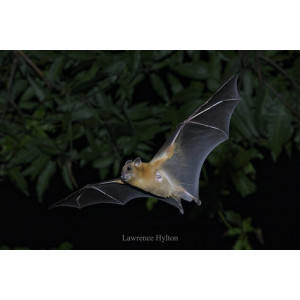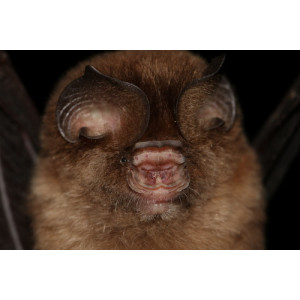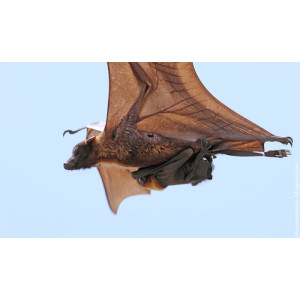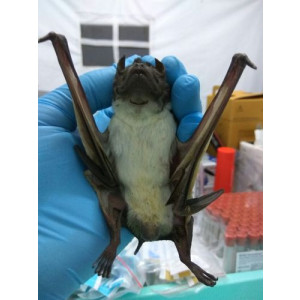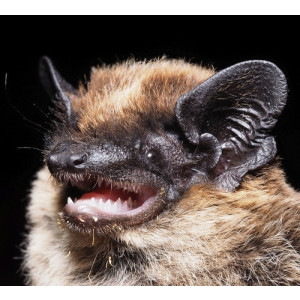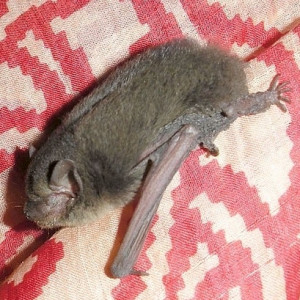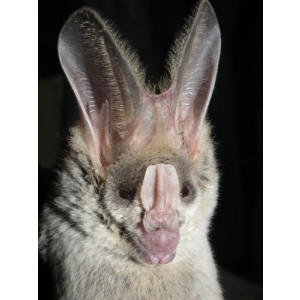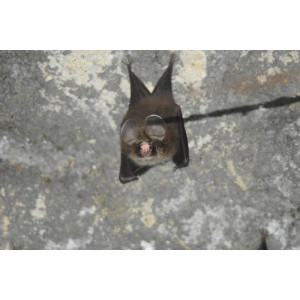@Suryo Suhono ( inaturalist.org)
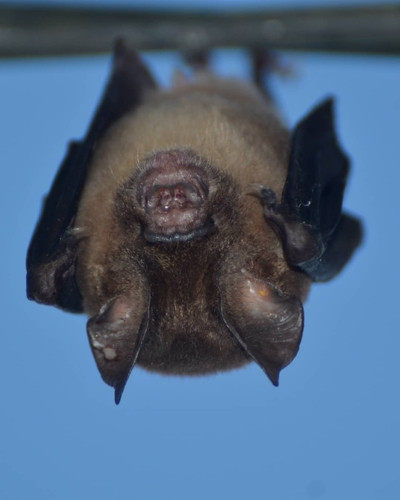
Horsfield’s Leaf-nosed Bat Did you see this animal?
Scientific Name : Hipposideros larvatus
Family : Hipposideridae
Order : Chiroptera
Class : Mammalia
Phylum : Chordata
Other Name : Intermediate roundleaf Bat
Habitat : Forest, Caves and Subterranean Habitats (non-aquatic)
Description : Horsfield's leaf-nosed bat is a medium-sized bat, with a wingspan of about 25-30 cm (10-12 in) and a body length of about 5-6 cm (2-2.4 in). It weighs around 10-15 g (0.35-0.53 oz).
In addition to its distinctive leaf-shaped nose, Horsfield's leaf-nosed bat has large, round ears and a brown or greyish-brown fur. Its wings are long and narrow, with pointed tips.
Horsfield's leaf-nosed bat is a social species, typically roosting in colonies of several hundred individuals. During the day, it hangs upside down from the roof of a cave or other shelter, using its feet to grip onto the surface. It is nocturnal and emerges at night to forage for insects.
Like other bats, Horsfield's leaf-nosed bat uses echolocation to navigate and locate prey. It emits high-pitched calls that bounce off of objects in its surroundings, allowing it to create a mental map of its environment.
The leaf-nosed bat primarily feeds on insects, including moths, beetles, termites, and other small arthropods. It typically captures prey in flight, using its wings and tail membranes to create a net-like structure to trap insects.
Females of this species typically give birth to a single offspring per year. The young are born in late spring or early summer and are able to fly within a few weeks. Horsfield's leaf-nosed bat has a relatively long lifespan for a bat, with individuals living up to 20 years in the wild.
The Horsfield's leaf-nosed bat is considered to be of least concern by the International Union for Conservation of Nature (IUCN), as it has a wide distribution and is relatively common in its range. However, habitat loss and disturbance can still pose a threat to its populations.
In addition to its distinctive leaf-shaped nose, Horsfield's leaf-nosed bat has large, round ears and a brown or greyish-brown fur. Its wings are long and narrow, with pointed tips.
Horsfield's leaf-nosed bat is a social species, typically roosting in colonies of several hundred individuals. During the day, it hangs upside down from the roof of a cave or other shelter, using its feet to grip onto the surface. It is nocturnal and emerges at night to forage for insects.
Like other bats, Horsfield's leaf-nosed bat uses echolocation to navigate and locate prey. It emits high-pitched calls that bounce off of objects in its surroundings, allowing it to create a mental map of its environment.
The leaf-nosed bat primarily feeds on insects, including moths, beetles, termites, and other small arthropods. It typically captures prey in flight, using its wings and tail membranes to create a net-like structure to trap insects.
Females of this species typically give birth to a single offspring per year. The young are born in late spring or early summer and are able to fly within a few weeks. Horsfield's leaf-nosed bat has a relatively long lifespan for a bat, with individuals living up to 20 years in the wild.
The Horsfield's leaf-nosed bat is considered to be of least concern by the International Union for Conservation of Nature (IUCN), as it has a wide distribution and is relatively common in its range. However, habitat loss and disturbance can still pose a threat to its populations.
Distribution in Bangladesh
References:
description written by:Asad U. Tanvir,Department of Zoology,Jagannath University,Dhaka; reviewed by:Muntasir Akash,Department of Zoology,University of Dhaka;Taxonomic Checklist:Red List of Bangladesh Volume 2: Mammals, 2015, IUCN; information sources:wikipedia,iucnredlist.org; photo credit:Nadim Parves,Jagannath University,Dhaka(), photo copyright: iNaturalist.more information please contact with us.
description written by:Asad U. Tanvir,Department of Zoology,Jagannath University,Dhaka; reviewed by:Muntasir Akash,Department of Zoology,University of Dhaka;Taxonomic Checklist:Red List of Bangladesh Volume 2: Mammals, 2015, IUCN; information sources:wikipedia,iucnredlist.org; photo credit:Nadim Parves,Jagannath University,Dhaka(), photo copyright: iNaturalist.more information please contact with us.
